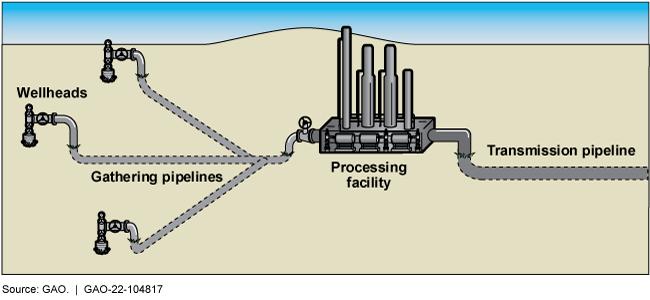Pipeline Safety: Operators of Natural Gas and Hazardous Liquid Gathering Lines Face Data Collection Challenges
Fast Facts
"Gathering pipelines" carry natural gas or hazardous liquid from wells to other pipelines or facilities. The Department of Transportation recently started collecting data on all of these pipelines—such as size and construction material—to better understand safety risks. All hazardous liquid gathering line operators started submitting data to DOT in 2021. Natural gas gathering line operators will do the same in 2023.
But for many operators, incomplete records and ownership changes over time may make collecting data tough. And collecting it may require significant resources.
DOT plans to continue outreach to operators on their reporting duties.
Gathering pipeline systems

Highlights
What GAO Found
Industry stakeholders described several challenges that operators of gathering lines—pipelines that carry gas or hazardous liquid from wells to other pipelines or facilities—may face in meeting new reporting requirements issued by the Pipeline and Hazardous Materials Safety Administration (PHMSA). Specifically, PHMSA required all hazardous liquid gathering line operators to submit annual reports with characteristic data, such as pipeline size and material of construction, starting in 2021, and natural gas gathering line operators to do the same starting in 2023 (see table).
Required Annual Reporting Data for Gathering Lines
|
Type of Gathering Line |
Required characteristic data |
|
Hazardous liquid |
Combined information detailing mileage by onshore/offshore location, material, diameter range, and operating stress level. |
|
Natural gas |
Miles of gathering line by diameter, decade installed, and material/corrosion prevention status; and number of leaks and repairs. |
Source: GAO Analysis of Pipeline and Hazardous Materials Safety Administration Annual Reporting Forms. | GAO-22-104817
Industry stakeholders told GAO that the limited availability of gathering line data and the resources needed to collect additional data may make reporting challenging. Older gathering lines may have less data available due to incomplete records and changes in ownership over time. Collecting data would require significant time, labor, and money. Stakeholders also noted that smaller operators—such as those with few employees—are less likely to have the expertise and resources needed to maintain or collect data. How these challenges will ultimately affect the amount of data operators report to PHMSA is unclear. GAO's analysis of data submitted in 2021 by hazardous liquid gathering line operators found that operators generally reported all required data, but the larger number of natural gas gathering line operators and miles of pipeline could result in PHMSA receiving less complete data from those operators. PHMSA officials say they plan to evaluate data submitted over time to determine gaps.
PHMSA has taken, and is planning, actions to make operators aware of recently amended gathering line reporting requirements. For hazardous liquid operators, PHMSA held a public meeting and presented information during two meetings of a national pipeline organization. PHMSA then received 85 annual reports in 2021 from those operators, which was in line with the agency's expectations. For natural gas, PHMSA estimates 500 operators will need to file reports for the first time in 2023—more than five times the 85 hazardous liquid operators that filed in 2021. Before PHMSA finalized the reporting requirements for natural gas gathering lines, GAO found that some industry representatives were unaware of proposed requirements. GAO brought these issues to PHMSA's attention and officials noted PHMSA is planning additional outreach for the natural gas rule, including to state industry associations. Such efforts should help PHMSA increase operators' awareness of and compliance with reporting requirements.
Why GAO Did This Study
PHMSA, within the Department of Transportation, has historically not regulated most gathering lines. However, factors such as increased extraction of natural gas and oil have increased the potential safety risks of these pipelines. To understand these risks better, PHMSA has taken steps in recent years to collect data, such as pipeline size and material type, from all gathering line operators.
The Consolidated Appropriations Act, 2021, includes a provision for GAO to review data collection by gathering line operators. This report addresses (1) stakeholder views on challenges operators may face in collecting gathering line data; and (2) steps PHMSA is taking to make operators aware of recently amended data reporting requirements.
GAO reviewed statutes and PHMSA final rules, annual reporting forms, and other relevant documents; analyzed data from annual reports filed in 2021 by historically unregulated hazardous liquid gathering line operators; and interviewed PHMSA officials and representatives from a range of industry stakeholders including five gathering line operators and 11 state and regional industry associations and 12 state regulatory agencies in the states with the greatest mileage of natural gas and hazardous liquid gathering lines.
For more information, contact Elizabeth Repko at (202) 512-2834 or repkoe@gao.gov.
